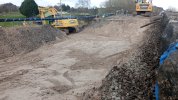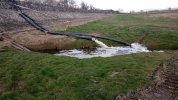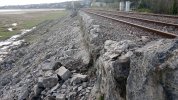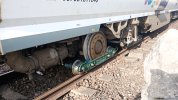RichardAsh1981
Member
- Joined
- 28 Oct 2017
- Messages
- 44
There are three pipes or hoses coming out on the seaward side, at different levels. Two come through the parapet wall, and one through the sea wall revetment. Presumably that one is the lower one visible in the photo, which goes through below the clay roof layer.
Finally, the void might have been there from the start - built in.
An obvious suggestion is that a leak in the lowest pump pipe might have been helping to wash sand out - it must have gone somewhere but pretty hard to spot in the bay full of the stuff!That raises another awkward question: did the collapse only happen because of the pump pipes/hoses at this point?
With hindsight, was running the pipe below the clay layer (presumably to minimise pumping costs) an expensive mistake?
Also, if the embankment was built with material containing organics, then it would shrink significantly if the organic content was able to rot down - which would depend on availability of air and water. Provide both and you can get serious shrinkage over time, without any removed material.
A couple of doors up a pond was filled in about 1975 (to ground level), shrinkage has lowered the front garden by about a foot, and caused at least one subsidence insurance claim.





